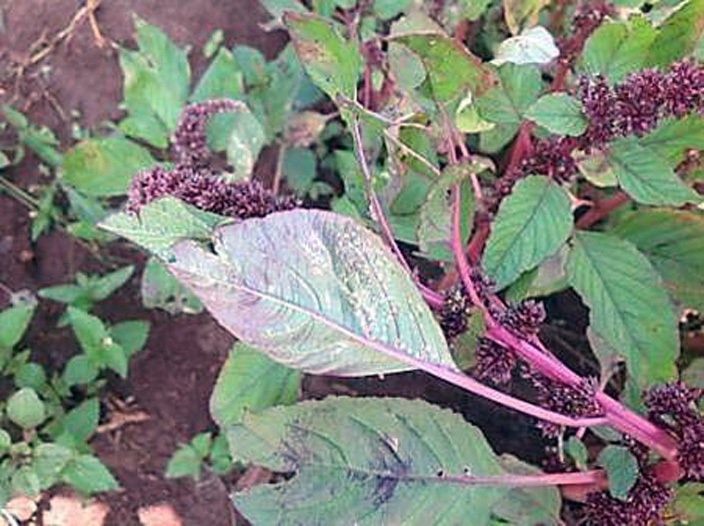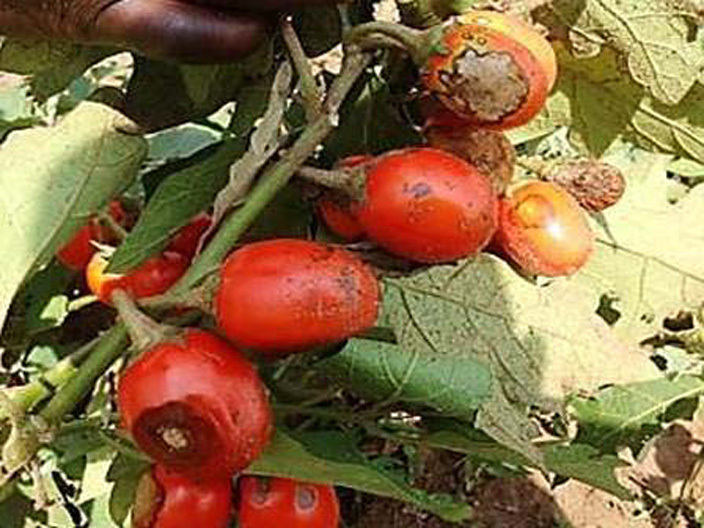Pests, disease frustrate NARO's effort to enhancing vegetable seed
Most affected vegetable include bbuga (Amaranthus blitum), nakati (Solanum aethiopicum), African eggplants (Solanum gilo) also called entula and malakwang (Hibiscus spp) in the north, among others. These are some of the indigenous vegetables being promoted by NARO through its research stations of NaCRRI, Namulonge and MuZARDI in Mukono.
The promotion of the consumption of indigenous vegetables may take a while due to an outbreak of pests and diseases that prevent the vegetables from producing quality seed.
Most affected vegetable include bbuga (Amaranthus blitum), nakati (Solanum aethiopicum), African eggplants (Solanum gilo) also called entula and malakwang (Hibiscus spp) in the north, among others. These are some of the indigenous vegetables being promoted by NARO through its research stations of NaCRRI, Namulonge and MuZARDI in Mukono.
The observation was made by Idd Ramathani, a research plant pathologist and co-principal investigator for Good seed Initiative project.
His observation comes after visiting vegetable growing areas of Nkokonjeru, Mpigi, Masaka, Buikwe, Namayumba and Kole, among others.
He said the most common pests discovered on the vegetables include beetles, caterpillars and other chewing insects.
Some diseases are fungal infections such as the white rust (Blister), found on amaranthus (bbuga and green doodo).
Other diseases include alternaria; leaf spot stem rot and stem blight. Entula are affected by fruit anthracnose and bacterial wilt. For nakati, it has been attacked by angular and grey leaf spot.
Ramathan explains the different diseases that affect the local vegetables in addition to preventive measures.
 Bbuga attacked by the White rust disease
Bbuga attacked by the White rust disease
White rust disease
White rust (Blister) of amaranthus is the most devastating disease for amaranthus (doodo) in Uganda. It is caused by a fungus called albugo occidentalis.
The disease affects all species of amaranthus, especially the Red Amaranthus (bbuga), mainly in the districts of districts of Wakiso, Mukono and Masaka.
These are spread by wind, insects and water and are sometimes seed-borne.
White rust is not harmful to human beings, however, no research has been undertaken to establish its effect if taken in high amounts.
Symptoms
The leaf has milky or whitish spots which sometimes are raised. They later rapture and release a powdery substance.
Effects on the plant productivity
- Lowers chlorophyll retention
- Causes parts of the leaf axes, along with flowers to swell, curl and become malformed.
- Seeds abort in malformed flowers and later drop off when harvesting.
 Holes created by leaf chewing insects
Holes created by leaf chewing insects
Management
- Farmers are encouraged to remove and destroy infected plants and use sprinkler irrigation.
- Crop rotation to prevent re-infection from the soils.
- Apply fungicides such as Ridomil Gold 68 WP (@ 0.2% foliar spray), copper oxide, chlorothalonil and sulphur: Other fungicides are organic such as rosemary oil, azadirachtin (neem products)
- Use clean certified seed or treated seed with fungicides
Stem rot
Stem rot (wet rot) is caused by a fungal pathogen. This disease is spread by air currents and infected seed. It is also spread through warm moist conditions as these favour disease development.
The disease leads to the rotting of the stems and leaves. These may cause loss of leaves especially during the rainy season.
To manage the stem rot, farmers are advised to use resistant varieties. This should be accompanied with the planting of certified disease free seeds.
Farmers should also avoid crowding of the plant to allow sufficient aeration.
Good field sanitation is also important. And spray copper when the disease is observed: bordeaux mix (Copper sulphate + hydrated lime (calcium hydroxide), copper oxchloride and copper hydroxide.
Anthracnose of Scarlet eggplant "entula" Solanum gilo (African eggplants)
Fruit Anthracnose is caused by fungal pathogen called Colletotrichum coccodes, a fungus that is saprophytic part of its life cycle and may survive from year to year in the soil and crop refuse.
It appears as round, sunken spots on green and ripe fruit. Spores develop on infections, often in circles around the centre, which later may contain pink spore masses.
Seed may be infected. Seedlings often have the disease, which later moves into developing foliage. Such infections are often unnoticed until fruit starts to grow, at which time the fruit-rot phase may become serious.
 Eggplants or Ntula affected by disease called Anthracnose
Eggplants or Ntula affected by disease called Anthracnose
Management
- Plant only high quality certified seed and transplants free from diseased areas.
- Practice at least a two-year rotation between susceptible species.
- Eliminate weeds and destroy affected plants by burying them deeply.
- Avoid root injury, which increase root infection.
- Destroy all plant refuse by burning. Use drip rather than overhead irrigation.
- Chemical control is more effective if it is combined with cultural controls. Some of the recommended chemicals include: captan, copper fungicides chlorothalonil & Bordeaux mix
Bacterial wilt
It is caused by a bacterium Ralstonia (Pseudomonas) solanacearum. The plant wilts and dies suddenly. The infected leaves wilt during sunny day and sometimes recover during cooler hours.
These signs are similar to the effects of lack of water.
During rapid development, the plant wilts quickly without yellowing.
Prevention
- Remove and destroy all infected plants immediately.
- Control nematodes as these could act as disease carriers.
- Rotate crops other than solanaceous crops. Rice, corn, beans, cabbage and sugarcane are found to be resistant to bacterial wilt.
- Since the bacteria can be transmitted through farm tools, wash or expose them to heat before using in another field
Angular and grey leaf spot
This is caused by a fungus called Stemphylium floridanum.
The fungus survives for a long time on plants and weeds. It is spread by wind and water.
Rains, dew, and overhead watering as these speed up the germination process.
Prevention
- Rotate crops.
- Avoid planting nakati in the shade.
- Avoid planting nakati where tomatoes, peppers, eggplants, or potatoes were grown the year before.
- Plant nakati in a raised bed to improve drainage and prevent diseases from spreading. Keep leaves as dry as possible. Water the soil - not the plants - to prevent splashing. Remove and destroy volunteer plants. Remove and destroy affected plants or deep plough remaining nakati plants into the ground at the end of the season.